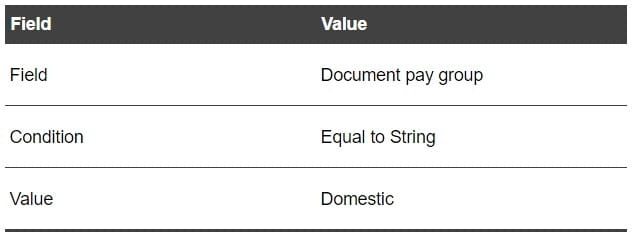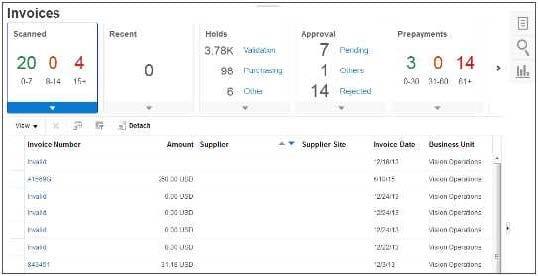Exam Details
Exam Code
:1Z0-1055-21Exam Name
:Oracle Financials Cloud: Payables 2021 Implementation EssentialsCertification
:Oracle CertificationsVendor
:OracleTotal Questions
:112 Q&AsLast Updated
:Jul 26, 2025
Oracle Oracle Certifications 1Z0-1055-21 Questions & Answers
-
Question 1:
What are the output formats supported for Electronic and Check format programs?
A. Electronic output format of XML, Check output format of rtf
B. Electronic output format of eText, Check output format of rtf
C. Electronic output format of Text, Check output format of Text
D. Electronic output format of DATA (csv), Check output format of Zipped PDFs
E. Electronic output format of PDF, Check output format of PDF
-
Question 2:
You applied a prepayment amount of $5,000 USD to a $10,000 USD invoice. At the time of prepayment,
the applicable tax rate was 5% ($250 USD); at the time of invoice creation, the tax rate is 10%. When you
set up taxes, you choose to Recalculate Taxes for the Applied Amount Handling option.
How will the resulting tax be calculated?
A. The tax for the prepayment is recalculated and the generated tax line amount will be $250 USD (5% * 10,000-5000).
B. The tax for the prepayment is recalculated to use the new invoice tax rate that is also used for the invoice line amount. The two generated tax lines show $1,000 USD (10% * 10,000) for the invoice line tax amount and a prepayment tax line of -500 USD (10% * -5000).
C. The tax calculation creates two tax lines: one for the invoice line amount and one for the prepayment with a negative amount. The two generated tax lines show $1,000 USD (10% * 10,000) for the invoice line tax amount and a prepayment tax line of -250 USD (5% * -5000).
D. The tax calculated on the prepayment is reversed completely and the tax rateapplied to the invoice line is retained.
-
Question 3:
A company has a requirement to pay small suppliers outside of Payables, but it does not want to manually
record each payment.
Which solution should you implement?
A. Create payments by using the Check Payment method for those suppliers and then destroy those checks.
B. Create payments by using Electronic Funds Transfer (EFT) for those suppliers but do not send the electronic file to the bank.
C. Create payments by using a clearing payment method for thosesuppliers because this payment method does not generate a file.
D. Create a payment by using a wire payment method for those suppliers.
-
Question 4:
Your customer has an electronic payment format program in use and wants all the documents to use the pay group "Domestic". What should you do to achieve this?
A. Define a user validation at the format program to include: Field "Document pay group", condition "Equal to String", value "Domestic", and Field "Document pay group", condition "Required" and value ?not applicable.
B. Define a user validation at the format program to include: Field "Document pay group", condition "Equal to String", and value "Domestic".
C. Modify your template to hard code the value "Domestic" for the pay group position.
D. Define a user validation at the formatprogram to include: Field "Document pay group", condition "Equal to String", value "Domestic", and Field "Format Program Code", condition "Equal to String" and value ? as desired.
-
Question 5:
Your company wants to generate intercompany transactions in USD but only if the amount involved is $3,000 USD or more. Which two intercompany system options are valid?
A. You cannot update the minimum transaction currency when intercompany currency is entered.
B. Intercompany invoices will be generated for the minimum accountable amount set at the payable invoice options and receivable system options.
C. Set the intercompany system option minimum transaction amount to $ 3,000 USD.
D. Approval rules need to set the allow of the intercompany transactions to be routed to the receiver or provider.
E. Set the intercompany system option minimum transaction amount to $2,999.99 USD.
-
Question 6:
Which three attributes are captured during the scanning of invoice images?
A. Invoice Date
B. Invoice Number
C. Terms Date
D. PO Number
E. Payment Method
-
Question 7:
Identify three statements that indicate the purpose of Functional Setup Manager.
A. It allows you to centrally manage the close processes across subledgers and ledgers.
B. it allows you to assign setup tasks to individuals with due dates where users must manually update their completion status.
C. It automatically marks the completion status of tasks as Completed once they have been completed.
D. It automatically generates lists of setup tasks in the correct sequence with dependencies highlighted.
E. It provides a central place to access and perform all of the setup steps across the applications.
-
Question 8:
You have assigned additional roles to an existing user. However, the new roles are not appearing for the user in their Navigator menu. What should you check?
A. Make sure you can query the user using Oracle Identity Manager (OIM) and the roles are assigned.
B. Make sure you can query the user from the Manage Users page and verify the roles assigned.
C. Make sure you ran the Retrieve Latest LDAP Changes program.
D. Make sure the user logs out and logs back in.
-
Question 9:
You want your expense auditors to audit only expenses reports for specific business units. How do you do this?
A. Create your own audit extension rules that correspond to the business unit.
B. Assign the auditors' specific data roles for the corresponding business units.
C. Create a custom duty role and assign the data roles to each auditor.
D. Make auditors the managersof the corresponding business unit to route expense reports properly.
-
Question 10:
You have created your first implementation project. You have assigned the Application Implementation
Consultant role to your user. However, you are unable to create and add roles to users in Oracle Identity
Management (OIM).
This issue is caused because you did not assign the ________.
A. Superuser role to your user
B. IT Security Manager role to your user
C. Application Implementation Manager role to your user
D. Line Manager role to your user
Related Exams:
1Z0-020
Oracle8i: New Features for Administrators1Z0-023
Architecture and Administration1Z0-024
Performance Tuning1Z0-025
Backup and Recovery1Z0-026
Network Administration1Z0-034
Upgrade Oracle9i/10g OCA to Oracle Database OCP1Z0-036
Managing Oracle9i on Linux1Z0-041
Oracle Database 10g: DBA Assessment1Z0-052
Oracle Database 11g: Administration Workshop I1Z0-053
Oracle Database 11g: Administration II
Tips on How to Prepare for the Exams
Nowadays, the certification exams become more and more important and required by more and more enterprises when applying for a job. But how to prepare for the exam effectively? How to prepare for the exam in a short time with less efforts? How to get a ideal result and how to find the most reliable resources? Here on Vcedump.com, you will find all the answers. Vcedump.com provide not only Oracle exam questions, answers and explanations but also complete assistance on your exam preparation and certification application. If you are confused on your 1Z0-1055-21 exam preparations and Oracle certification application, do not hesitate to visit our Vcedump.com to find your solutions here.

